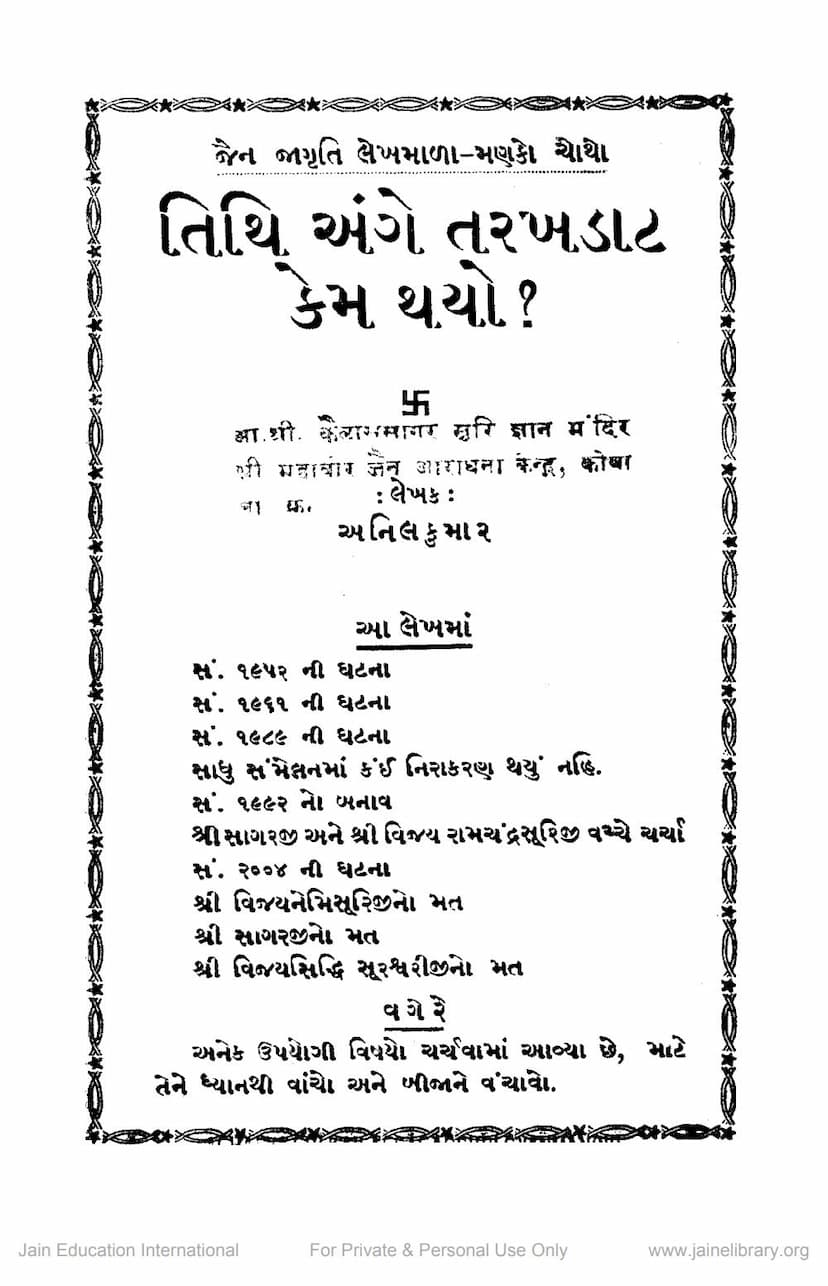Tithi Ange Tarkhadat Kem Thayo
Added to library: September 2, 2025

Summary
Here's a comprehensive summary of the Jain text "Tithi Ange Tarkhadat Kem Thayo" (Why the Turmoil Regarding Dates?):
This book, authored by Anilkumar Jain and published by Kantilal Maneklal Shah in Ahmedabad, delves into the historical controversies and debates surrounding the calculation and observance of specific Jain religious dates (tithis), particularly focusing on the Paryushan festival. The text aims to explain how these disputes arose and their consequences.
Key Themes and Events Discussed:
-
Importance of Tithis: The author begins by reiterating the significance of festival tithis in Jainism, the reasons for their worship, and the traditional methods of their determination, including the principles of "audayik tithi" (tithi observed based on sunrise) and scriptural rules regarding the increase and decrease of tithis.
-
The "Turmoil" of the 19th Century Onwards: The core of the book traces the escalating disagreements over tithis, which began in the 19th century and continued into the 20th. The author highlights the shift in authority from the "Shri Poo" (senior monks) to the "Sanyogi Sadhus" (ascetics focused on renunciation) as a contributing factor, stating that the latter ultimately gained dominance in social matters, including the determination of religious observances.
-
Specific Incidents and Debates:
- 1895 (Samvat 1952): A pivotal event involved the month of Bhadrapada Sud ( Shukla) having a diminished fifth day (Kshay). Acharya Shrimad Atmaramji Maharaj permitted the observance of the fifth day as the third day due to its diminished state, impacting the Paryushan festival. This decision was followed by many, demonstrating devotion to the Guru. However, minor disagreements arose in specific locations.
- 1904 (Samvat 1961): Another instance of a diminished Bhadrapada Sud fifth day occurred. Acharya Shrimad Sagaranand Surishwarji Maharaj adopted the third tithi as the fifth, deviating from the common practice of observing the fourth tithi (as per Chandashugandu Panchang) when the fifth was diminished. This led to a split in observance.
- 1932 (Samvat 1989): The Chandashugandu Panchang again showed a diminished fifth tithi for Bhadrapada Sud. Acharya Shrimad Sagaranand Surishwarji Maharaj proposed observing the fourth tithi. However, Acharya Shrimad Vijaynit Surishwarji Maharaj published a booklet opposing this, leading to a majority observing the fourth tithi.
- 1935 (Samvat 1992): This year saw significant confusion. Acharya Shrimad Vijaydan Surishwarji Maharaj suggested addressing the tithi issue at a Sadhu Sammelan (gathering of monks). However, Acharya Shrimad Vijaynemisuriji Maharaj deflected the discussion, stating it was an issue for the Tapagachha (a specific Jain monastic lineage) and not for monks of other lineages. This highlighted the unresolved nature of the tithi problem. In the same year, a dispute arose between Acharya Shrimad Vijaynemisuriji Maharaj and Acharya Shrimad Vijay Siddhisuiriji Maharaj. While initially agreeing to observe the fourth tithi (a Saturday), Acharya Shrimad Vijaynemisuriji Maharaj later changed his stance to the fifth tithi (a Sunday), causing distress to Acharya Shrimad Vijay Siddhisuiriji Maharaj, who maintained his adherence to the fourth tithi. This led to different sects observing the festival on different days.
- 1947 (Samvat 2004): The issue resurfaced with a diminished Bhadrapada Sud fifth day. Acharya Shrimad Vijaynemisuriji Maharaj and others adhered to the fourth tithi, while Acharya Shrimad Vijaypratap Suri and his followers observed the fifth tithi, aligning with Acharya Shrimad Sagaranand Suri's view.
-
Different Views and Arguments:
- Acharya Shrimad Vijaynemisuriji Maharaj's View: This group believes that since Paryushan was originally established by Acharya Kalikacharya on the fourth tithi adjacent to the fifth, the focus should be on this adjacency. They argue that when the fifth tithi is diminished, the third tithi is affected, and thus the fourth tithi, being closest, should be observed. They often refer to specific scriptural passages and interpretations to support their stance.
- Acharya Shrimad Sagaranand Surishwarji Maharaj's View: This group emphasizes the principle that festival tithis (like the full moon, new moon, fourth, and fifth of Bhadrapada) should not be diminished or increased. They maintain that if a tithi is diminished, the preceding tithi should be observed, and if increased, the following tithi should be observed. They criticize the practice of observing the fourth tithi when the fifth is diminished.
-
The Role of Panchangs (Almanacs): The text frequently refers to the "Chandashugandu Panchang," a widely followed almanac, and other panchangs. Disputes often arose when different panchangs showed variations in tithi calculations, especially during diminished or increased tithis.
-
Criticism of Practices: The author critically examines the arguments and practices of both sides. For example, the deviation from established traditions without wider consensus is questioned. The interpretation of scriptural verses and the application of rules are also debated. The author points out inconsistencies in arguments, such as how the principle of "kshaye purva" (observing the previous tithi in case of diminution) is applied selectively.
-
Impact on the Jain Community: The book stresses that these unresolved disputes have led to fragmentation and division within the Jain community, impacting religious harmony and adherence to practices. The author expresses regret that important issues were not resolved in monastic gatherings.
-
The Author's Perspective: The author appears to present a balanced account of the historical events and the differing viewpoints. While acknowledging the scholarly nature of the involved Acharyas, the author highlights the negative consequences of these disagreements on the Sangha (community).
-
Call for Resolution: The text concludes by stating the intention to present a final article on "What Should Be Done Now?" to guide the community towards resolution and establish unity regarding tithi observances. The ultimate goal is to end the disputes and foster progress within Jainism.
In essence, "Tithi Ange Tarkhadat Kem Thayo" is a historical and analytical account of a significant theological and practical debate within Jainism concerning the accurate calculation and observance of religious dates, highlighting the historical events, the differing interpretations of scriptures and practices, and the lasting impact of these disagreements on the Jain community.